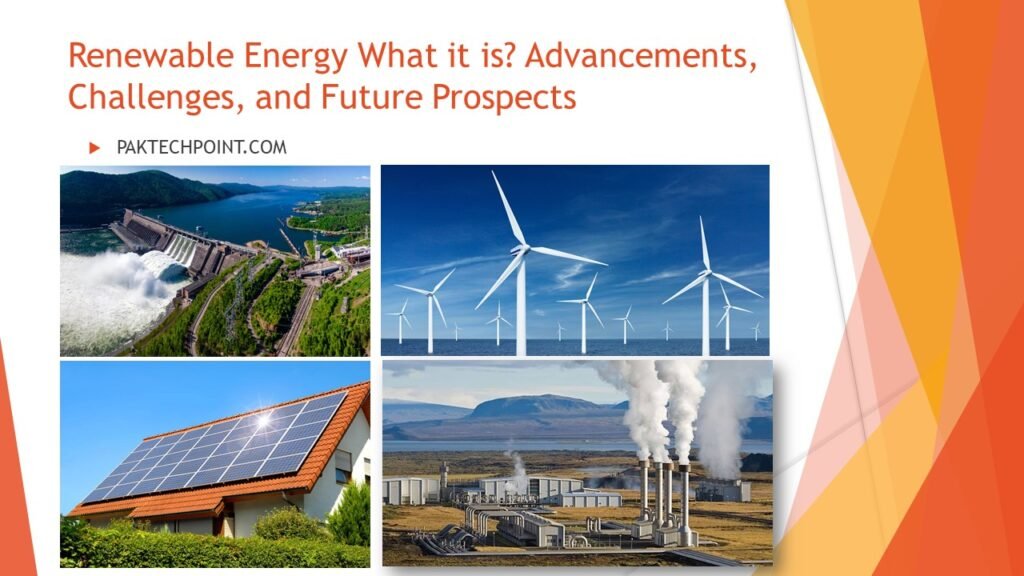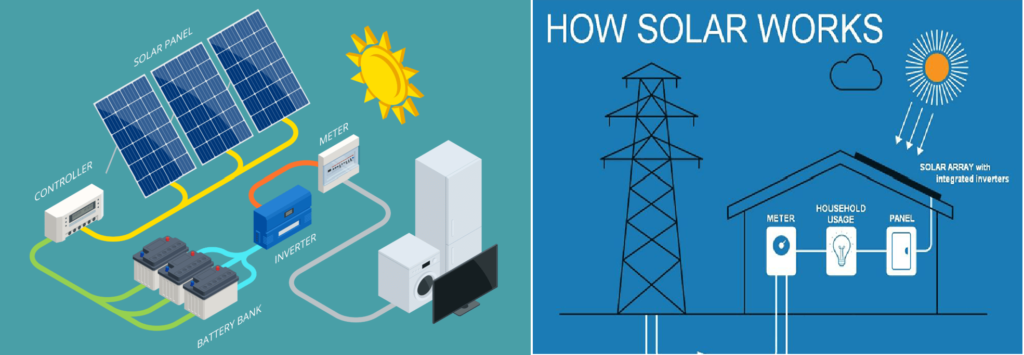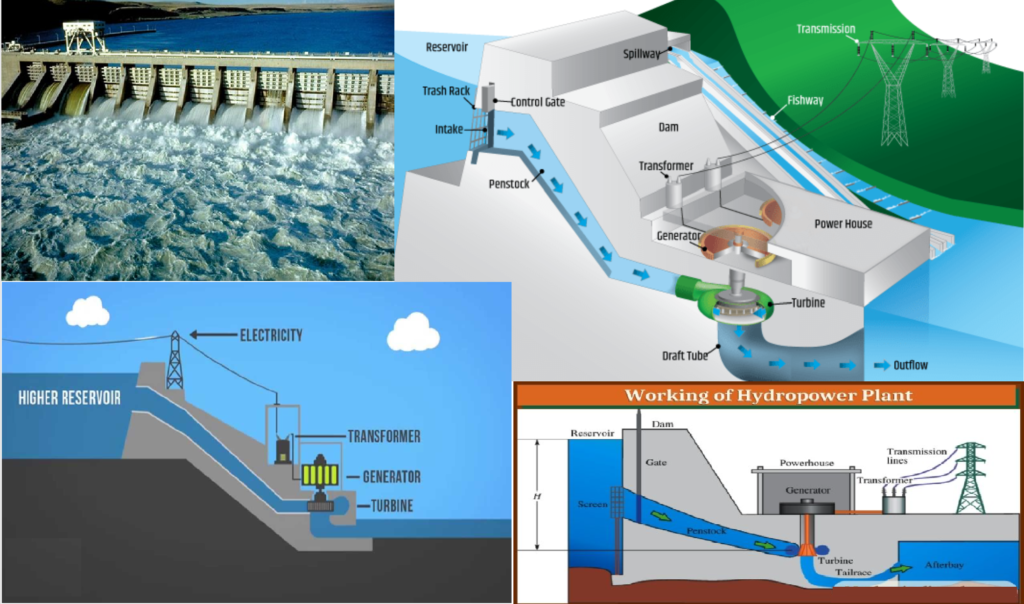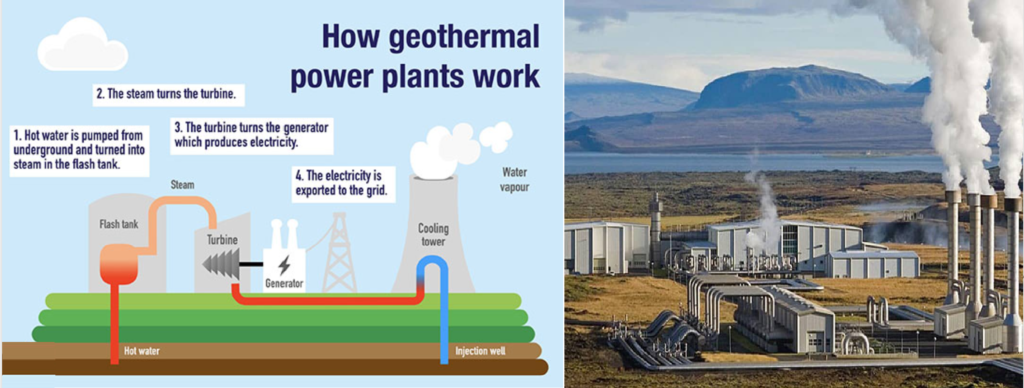In a world striving for sustainability and environmental conservation, the spotlight shines brightly on renewable energy sources as the key to a cleaner and greener future. The global call for reducing our reliance on fossil fuels and mitigating the impacts of climate change has ushered in a new era of energy innovation. Renewable resources, harnessed from the forces of nature, have emerged as the driving force behind this transformative change.

In this comprehensive article, we embark on an enlightening journey to explore the boundless potential of renewable energy. From the towering wind turbines that gracefully harness the power of the wind to the sun-kissed solar panels that convert sunlight into electricity, we uncover the diverse and sustainable energy solutions available to us. Delving into the most common searched topics on Google, we unravel the technical aspects behind these eco-friendly alternatives, making them accessible to all.
What is Renewable Energy?
Renewable energy is a rapidly evolving field that encompasses various sustainable energy sources harnessed from nature, such as solar, wind, hydro, geothermal, and biomass. In recent years, the world has witnessed a significant shift towards renewable energy as a viable alternative to traditional fossil fuels. This seismic change is driven by the need to address climate change, reduce greenhouse gas emissions, and transition towards a more sustainable energy future.
As society increasingly seeks to understand and embrace renewable energy, a plethora of questions arises. This comprehensive article aims to delve into the most searched items on Google related to renewable energy, providing valuable insights into the technical aspects, advancements, challenges, and future prospects of this transformative industry.
1. Solar Energy:
Solar energy ranks among the most searched topics, reflecting the growing interest in harnessing the power of the sun. Photovoltaic (PV) technology converts sunlight into electricity, while solar thermal systems use the sun’s heat for water heating and space heating. We will explore the efficiency of solar panels, advancements in PV technology, and the integration of solar energy into the power grid.

Solar energy works by harnessing the power of the sun and converting it into usable electricity through photovoltaic (PV) technology. This renewable energy process is clean, sustainable, and environmentally friendly, making it a popular choice in the quest for a greener future.
The basic working principle of solar energy can be summarized in the following steps:
- Solar Panels: Solar panels, also known as solar photovoltaic (PV) modules, are the heart of the solar energy system. These panels are made up of numerous solar cells, typically composed of silicon. When sunlight strikes the surface of the solar panel, it excites the electrons within the solar cells, creating a flow of direct current (DC) electricity.
- Inverter: The DC electricity generated by the solar panels is then sent to an inverter. The inverter’s main function is to convert the DC electricity into alternating current (AC) electricity, which is the standard form of electricity used in homes and businesses.
- Electrical Load or Grid Connection: The AC electricity produced by the inverter can be used to power electrical loads directly within the building where the solar panels are installed. Any excess electricity not immediately consumed is fed back into the electrical grid, effectively spinning the electricity meter backward and providing credit for the surplus energy.
- Net Metering: In regions with net metering policies, excess electricity generated by the solar panels can be fed back into the grid. The utility company credits the energy producer for the surplus energy, which can be used to offset the electricity consumption during times when the solar panels are not producing enough electricity, such as at night.
- Battery Storage (Optional): Some solar energy systems incorporate battery storage to store excess electricity generated during sunny days. These batteries can be used to power the building during periods of low sunlight or at night when the solar panels are not actively generating electricity.
- Monitoring and Control: Advanced solar energy systems may include monitoring and control features, allowing users to track the energy production and consumption in real-time, optimizing energy usage and efficiency.
Solar energy is versatile and can be applied to various scales, from small residential systems to large-scale solar farms that generate electricity for entire communities. With advancements in solar technology and decreasing costs, solar energy has become an increasingly viable and attractive solution to meet the world’s energy needs sustainably while reducing greenhouse gas emissions and combating climate change.
2. Wind Energy:
Wind energy is another sought-after topic, as wind turbines become increasingly prevalent on landscapes worldwide. We will delve into the working principle of wind turbines, advancements in turbine design for optimal efficiency, and the role of wind farms in large-scale energy production.
Wind energy works by harnessing the kinetic energy of the wind and converting it into usable electricity through wind turbines. This renewable energy process is environmentally friendly, sustainable, and has the potential to supply a significant portion of the world’s electricity needs.

The basic working principle of wind energy can be summarized in the following steps:
- Wind Turbines: Wind turbines are the primary devices used to capture wind energy. These turbines consist of large rotor blades connected to a hub. When the wind blows, it causes the rotor blades to spin.
- Generator: The spinning rotor blades are connected to a generator, which converts the mechanical energy of the spinning blades into electrical energy. Inside the generator, a shaft connected to the rotor blades rotates coils of wire within a magnetic field, inducing an electric current.
- Electrical System: The electric current produced by the generator is in the form of alternating current (AC). It is then converted to a higher voltage by a transformer, making it suitable for transmission through power lines.
- Grid Connection: The electricity generated by wind turbines is usually connected to the electrical grid, allowing it to be distributed and used by homes, businesses, and industries. Wind farms, consisting of multiple wind turbines, are often located in windy areas to maximize electricity production.
- Power Control and Monitoring: Advanced wind energy systems include power control and monitoring features to optimize the performance of the turbines. These features ensure that the wind turbines operate efficiently and safely under varying wind conditions.
- Wind Resource Assessment: Before constructing a wind farm, developers conduct a thorough wind resource assessment to identify the best locations for maximum wind energy potential. Wind speed and direction data are collected over an extended period to determine the feasibility and viability of the project.
- Energy Storage (Optional): Some wind energy systems incorporate energy storage solutions, such as batteries, to store excess electricity generated during periods of strong winds. These batteries can then be used to supply power during times when the wind is not blowing or during peak demand periods.
Wind energy is a rapidly growing renewable energy source, contributing significantly to the global energy mix. It provides a clean and sustainable alternative to fossil fuels, reducing greenhouse gas emissions and helping combat climate change. As wind technology continues to advance and become more cost-effective, it is expected to play an increasingly vital role in the transition to a more sustainable and greener energy future.
3. Hydropower Energy: Tapping into Flowing Rivers
Hydropower, derived from the energy of flowing water, is a prominent renewable energy source. We will discuss the different types of hydropower systems, such as run-of-the-river, pumped storage, and tidal power, along with the challenges and environmental considerations associated with large dam construction.

Hydropower energy, also known as hydroelectric power, is a renewable energy technology that harnesses the energy of flowing or falling water to generate electricity. It is one of the oldest and most widely used forms of renewable energy, with a long history of providing clean and sustainable electricity. The basic working principle of hydropower energy can be explained in the following steps:
- Water Source: The first step in hydropower energy production is identifying a suitable water source, which can be a river, stream, or reservoir with a significant flow of water.
- Dam or Reservoir: In many hydropower projects, a dam is constructed across a river to create a reservoir. The dam holds back the water, creating a large artificial lake at a higher elevation than the downstream river.
- Penstock: A penstock is a large pipe or conduit that carries water from the reservoir to the turbine. The pressure from the elevated water level in the reservoir helps to drive the water through the penstock.
- Turbine: The penstock directs the high-pressure water to the turbine. The turbine is a large wheel with blades or buckets that are turned by the force of the flowing water. The turbine converts the kinetic energy of the moving water into mechanical energy.
- Generator: The turbine is connected to a generator, which is essentially an electric motor in reverse. As the turbine rotates, it spins the generator’s rotor, creating a magnetic field. This magnetic field induces an electric current in the generator’s stator coils, producing electricity.
- Transmission Lines: The electricity generated by the generator is in the form of alternating current (AC). It is then sent through transformers to increase the voltage for efficient transmission through power lines.
- Grid Connection: The electricity from the hydropower plant is connected to the electrical grid, where it can be distributed to homes, businesses, and industries. Hydropower plants are often strategically located near demand centers to facilitate efficient power distribution.
- Water Release: After passing through the turbine, the water is released back into the downstream river or channel. This ensures that the water cycle is maintained, and the environment is not adversely impacted by the hydropower operation.
- Pumped Storage (Optional): Some hydropower facilities include pumped storage, which is a method of storing excess electricity by using it to pump water back into the reservoir during periods of low demand. This stored water can then be released and used to generate electricity during peak demand periods.
Hydropower energy is considered a clean and renewable energy source because it does not produce greenhouse gas emissions or air pollutants during operation. It is also highly reliable and can provide a stable and continuous supply of electricity, making it an essential component of many countries’ energy portfolios. Additionally, hydropower plants can be designed to accommodate various water flow conditions, making them versatile and adaptable to different environmental and operational requirements.
4. Geothermal Energy: Unleashing Earth’s Heat
Geothermal energy harnesses the Earth’s natural heat from within its core. This intriguing energy source holds immense potential for both electricity generation and direct heating applications. We will explore geothermal power plants, geothermal heat pumps for residential and commercial use, and the geology behind geothermal resources.

Geothermal energy is a renewable and sustainable form of energy that harnesses the heat from the Earth’s core to generate electricity or provide heating and cooling for buildings. It relies on the natural heat stored in the Earth’s crust, and its working principle can be explained as follows:
- Heat Source: The Earth’s core is extremely hot, with temperatures reaching several thousand degrees Celsius. This heat is a result of the planet’s formation and the decay of radioactive isotopes in the Earth’s mantle.
- Geothermal Reservoir: The heat from the Earth’s core is conducted to the shallow subsurface, creating geothermal reservoirs of hot water or steam. These reservoirs are found in regions with active volcanic activity, geothermal hotspots, or areas with naturally permeable rock formations that allow the movement of hot fluids.
- Drilling: To access the geothermal reservoir, wells are drilled deep into the Earth’s crust to reach the hot water or steam. The depth of the wells can vary depending on the location and the specific geothermal resource.
- Geothermal Power Plant: There are two main types of geothermal power plants: dry steam plants and flash steam plants.
- Dry Steam Plants: In locations where there is a natural abundance of steam in the geothermal reservoir, dry steam plants can be used. The steam from the well is directly used to drive a turbine connected to a generator, producing electricity.
- Flash Steam Plants: In many geothermal reservoirs, the fluid is in the form of hot water rather than steam. In flash steam plants, the hot water is pumped to a lower pressure through a separator. The sudden pressure drop causes the water to “flash” into steam, which is then used to drive a turbine and generate electricity.
- Binary Cycle Plants (Optional): In some geothermal resources with lower temperature fluids, binary cycle power plants can be used. The hot geothermal fluid is passed through a heat exchanger, where it heats a secondary fluid with a lower boiling point (such as isobutane or isopentane). The secondary fluid vaporizes and drives a turbine connected to a generator to produce electricity.
- Direct Use: Geothermal energy can also be used directly for heating and cooling purposes. In areas with lower temperature geothermal resources, the hot water can be pumped directly to buildings for space heating or used in district heating systems. Conversely, in warm climates, geothermal cooling systems can provide air conditioning by using the cool geothermal water to absorb heat from buildings.
- Replenishment: Geothermal reservoirs are naturally replenished by the Earth’s internal heat, making them a sustainable and long-term source of energy.
Geothermal energy is considered a clean and environmentally friendly energy source as it produces minimal greenhouse gas emissions and air pollutants compared to fossil fuels. It is also a reliable and consistent energy source, as it operates 24/7 and is not affected by weather conditions like solar and wind energy. Additionally, geothermal power plants have a relatively small land footprint, making them suitable for both large-scale and distributed energy generation.
5. Biomass Energy: Sustainable Biofuels and Beyond
Biomass energy involves using organic materials such as wood, agricultural residues, and waste to produce heat, electricity, and biofuels. We will discuss the various biomass conversion technologies, including anaerobic digestion and bioenergy from algae, and how they contribute to reducing carbon emissions.
6. Grid Integration and Energy Storage:
The seamless integration of renewable energy into existing power grids is a major concern for energy providers and consumers alike. We will explore grid management strategies, smart grid technologies, and energy storage solutions such as batteries, pumped hydro storage, and thermal energy storage to ensure stable and reliable power supply.
7. Challenges of Renewable Energy Adoption: Addressing the Transition
The widespread adoption of renewable energy faces several challenges, including intermittency, energy storage limitations, and infrastructure upgrades. We will analyze the technical aspects of these challenges and explore innovative solutions to overcome them.
8. Future Prospects and Innovations: Green Energy Revolution
The future of renewable energy holds great promise. We will explore cutting-edge innovations in renewable technologies, including floating solar farms, offshore wind turbines, hydrogen fuel cells, and artificial intelligence for optimized energy management.
Difference Between Renewable and Non Renewable Energy
Following table highlighting the main differences between renewable and non-renewable energy:
| Aspect | Renewable Energy | Non-Renewable Energy |
|---|---|---|
| Source | Derived from naturally occurring and replenishable resources, such as sunlight, wind, water, biomass, and geothermal heat. | Derived from finite resources, such as fossil fuels (coal, oil, natural gas) and nuclear fuels (uranium). Once depleted, they cannot be replenished within a human lifetime. |
| Sustainability | Sustainable over long periods and can be continuously harnessed without depleting the energy source. | Non-sustainable as they are limited in supply and will eventually run out over time. |
| Environmental Impact | Low greenhouse gas emissions and minimal environmental pollution during energy generation. | High greenhouse gas emissions, leading to air pollution, climate change, and environmental degradation. |
| Cost and Price Stability | Renewable technologies are becoming more cost-competitive and offer stable long-term energy prices. | Non-renewable energy costs can fluctuate due to resource availability, geopolitical factors, and extraction costs. |
| Energy Security | Provides energy security by reducing reliance on imported fuels and geopolitical dependencies. | May face energy security issues due to reliance on imports and geopolitical conflicts over energy resources. |
| Availability | Abundant in many regions and readily available for harnessing. | Concentrated in specific regions and may require extensive exploration and extraction efforts. |
| Impact on Health | Generally considered cleaner and safer, with fewer health hazards during energy generation. | May pose health risks due to air pollution, water contamination, and nuclear waste disposal. |
| Long-term Viability | Sustainable for future generations, ensuring a cleaner and greener environment. | Unsustainable for future generations, leading to concerns about energy scarcity. |
| Examples | Solar, wind, hydroelectric, geothermal, biomass energy. | Coal, oil, natural gas, nuclear energy. |
It’s important to note that transitioning to renewable energy sources is crucial for mitigating climate change and achieving a sustainable energy future.
Is nuclear energy renewable?
No, nuclear energy is not considered renewable. Although it is often discussed in the context of clean energy due to its low greenhouse gas emissions during electricity generation, it is classified as a non-renewable energy source.
Nuclear energy is obtained from the fission (splitting) of uranium and other radioactive elements. While uranium is relatively abundant, it is still considered a finite resource. The Earth’s uranium reserves will eventually be depleted over time, and once used, nuclear fuel cannot be easily replenished or regenerated within a human timeframe.
Additionally, nuclear energy production involves complex processes, including mining, enrichment, and waste disposal, which are energy-intensive and have environmental impacts. Therefore, while nuclear energy can play a role in the transition to low-carbon energy systems, it is not considered a renewable energy source like solar, wind, hydro, geothermal, or biomass energy.
Renewable Resources Examples
Renewable resources are natural sources of energy that can be replenished naturally and sustainably. They are considered environmentally friendly because they do not deplete over time and have minimal environmental impact compared to non-renewable resources. Here are some examples of renewable resources:
- Solar Energy: Solar power harnesses the energy from the sun using photovoltaic cells or solar thermal collectors to generate electricity or heat water.
- Wind Energy: Wind turbines convert the kinetic energy of the wind into electrical energy, providing a clean and abundant source of power.
- Hydroelectric Power: Hydroelectric power is generated by capturing the energy of flowing or falling water using dams and turbines.
- Geothermal Energy: Geothermal power utilizes the heat from the Earth’s core to produce electricity or for direct heating purposes.
- Biomass Energy: Biomass includes organic materials such as wood, agricultural residues, and organic waste that can be converted into bioenergy through processes like combustion, anaerobic digestion, or biochemical conversion.
- Tidal Energy: Tidal power harnesses the energy from ocean tides using tidal turbines to generate electricity.
- Wave Energy: Wave power captures the kinetic energy from ocean waves and converts it into electricity.
- Hydropower: Hydropower encompasses various forms of water energy, including traditional hydroelectric dams and run-of-river systems.
- Biofuels: Biofuels are derived from organic materials like plants or algae and can be used as an alternative to fossil fuels in transportation and energy production.
These renewable resources provide sustainable alternatives to traditional fossil fuels and contribute to reducing greenhouse gas emissions and mitigating climate change. They play a crucial role in the transition to a more sustainable and environmentally friendly energy system.
Conclusion:
Renewable energy is no longer a futuristic concept but a tangible reality shaping the global energy landscape. From solar power to wind energy, hydropower, geothermal energy, and biomass, the advancements in renewable technologies are transforming the way we generate and consume energy. This article has provided a comprehensive overview of the most searched items on Google related to renewable energy, touching upon technical aspects, challenges, and future prospects. As the world embraces sustainable energy solutions, the green energy revolution is set to propel us towards a cleaner, greener, and more sustainable future.